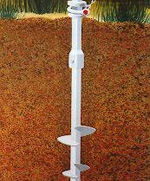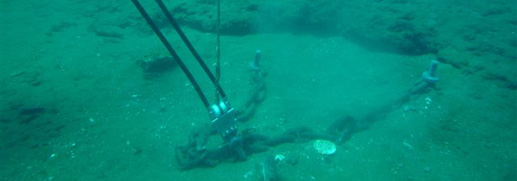


Brochure downloads
 Seaflex brochure A (300 KB)
Seaflex brochure A (300 KB)
 Seaflex brochure B (113 KB)
Seaflex brochure B (113 KB)
Technical details
The "Helix Mooring Anchor" is 3.6 meters of 3.8 centimetres solid square rod that has been hot dipped galvanised and welded to International Standards. The three ground plates have a diameter of 254 mm, 305 mm and 356 mm consecutively. The anchor is driven into the seabed until a holding pressure of 2000 psi is achieved. Should the requisite pressure not be achieved, extension sections and extra plates are added until the pressure threshold is reached.
The Helix Mooring Anchor has a long proven record for holding during storm events in the USA. In the Whitsundays, a ten meter catamaran held her position through the category three cyclone Ului in 2010. The vessel was in the Mandalay Grid and as the cyclone passed over her position she became exposed to open seas and experienced wind strengths in excess of 150 kilometres an hour.
The Vineyard Haven Pull tests have been conducted to prove the holding power of the system and were overseen by several United States Harbour Masters.
High-Holding:
The results of the first test (performed in Vineyard Haven, Massachusetts, under the watchful eye of area harbour masters, a marine industry reporter, and a representative of Boat/US) are typical of all the load tests performed.
Vineyard Haven, Pull Test Results |
||
| Mooring Type | Bottom Condition | Breakout Force |
|---|---|---|
| 350-lb. Mushroom | 5 ft. deep in mud | 2,000 lb. |
| 500-lb. Mushroom | in sand bottom | 1,700 lb. |
| 3,000-lb. Concrete USCG block | set in mud | 2,100 lb. |
| 6,000 lb. cement block | on sand bottom | 3,200 lb. |
| 8/10 Helix | soft clay mud | 20,800+ lb. |
The Breakout Force of the 8/10 Helix was greater than the threshold limitations of the testing equipment. Actual breakout of the Anchor was not achieved.
Environmentally Friendly:
Because these anchors don't drag around the harbour bottoms and can be effective with shorter scopes, they are preferred in environmentally sensitive areas and have been recommended by several United States Environmental Agencies.
Whitsunday Moorings and Marine Construction has increased the overall loading capacity of the Helix system by adding a rectangular two tonne concrete block. The rectangular shaped block will replace the previous trapezoid shape as the trapezoid has several design limitations. The new shape has a single 50 mm ovoid loop that forms two eyes at either end of the block. This stabilises the mooring structure and the relative forces applied to each section of the mooring.
For further information on how the mooring works, see the mooring animations on the Moorings page.
Seaflex (or a product like it) is what Government Authorities will eventually insist on for in all moorings. The reason they will make this change is primarily environmental (for more on this see our "QLD Government Downloads" section); the reason Whitsunday Moorings and Marine Construction recommends it is for safety.
As a result of the devastating storms over the last few years we have learnt a lot of lessons. One of the primary lessons was that stretch is good. During the 2008 storm many vessels parted from their mooring due to the failure of deck gear. By using as many components that can flex, move and stretch as possible we reduce the snatching effect and keep your mooring attached to the front of your boat.
Each Seaflex is individually sourced depending on your vessel configuration.
More information on Seaflex can be seen in their e-brochure.